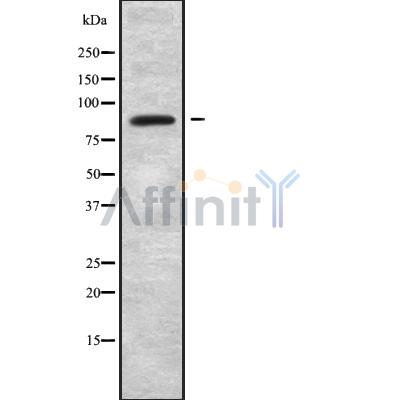ARHGEF6 Antibody - #DF9865
| Product: | ARHGEF6 Antibody |
| Catalog: | DF9865 |
| Description: | Rabbit polyclonal antibody to ARHGEF6 |
| Application: | WB IHC IF/ICC |
| Reactivity: | Human, Mouse, Rat |
| Prediction: | Pig, Bovine, Horse, Sheep, Rabbit, Dog |
| Mol.Wt.: | 87kDa; 87kD(Calculated). |
| Uniprot: | Q15052 |
| RRID: | AB_2843059 |
Related Downloads
Protocols
Product Info
*The optimal dilutions should be determined by the end user.
*Tips:
WB: For western blot detection of denatured protein samples. IHC: For immunohistochemical detection of paraffin sections (IHC-p) or frozen sections (IHC-f) of tissue samples. IF/ICC: For immunofluorescence detection of cell samples. ELISA(peptide): For ELISA detection of antigenic peptide.
Cite Format: Affinity Biosciences Cat# DF9865, RRID:AB_2843059.
Fold/Unfold
Alpha Pix; Alpha-Pix; ARHG6_HUMAN; ARHGEF6; COOL 2; COOL-2; COOL2; Mental retardation, X linked 46; MRX46; PAK interacting exchange factor alpha; PAK-interacting exchange factor alpha; PIXA; Rac/Cdc42 guanine exchange factor (GEF) 6; Rac/Cdc42 guanine nucleotide exchange factor (GEF) 6; Rac/Cdc42 guanine nucleotide exchange factor 6; Rho guanine nucleotide exchange factor 6;
Immunogens
A synthesized peptide derived from human ARHGEF6, corresponding to a region within N-terminal amino acids.
- Q15052 ARHG6_HUMAN:
- Protein BLAST With
- NCBI/
- ExPASy/
- Uniprot
MNPEEQIVTWLISLGVLESPKKTICDPEEFLKSSLKNGVVLCKLINRLMPGSVEKFCLDPQTEADCINNINDFLKGCATLQVEIFDPDDLYSGVNFSKVLSTLLAVNKATEDQLSERPCGRSSSLSAANTSQTNPQGAVSSTVSGLQRQSKTVEMTENGSHQLIVKARFNFKQTNEDELSVCKGDIIYVTRVEEGGWWEGTLNGRTGWFPSNYVREIKSSERPLSPKAVKGFETAPLTKNYYTVVLQNILDTEKEYAKELQSLLVTYLRPLQSNNNLSTVEVTSLLGNFEEVCTFQQTLCQALEECSKFPENQHKVGGCLLSLMPHFKSMYLAYCANHPSAVNVLTQHSDELEQFMENQGASSPGILILTTNLSKPFMRLEKYVTLLQELERHMEDTHPDHQDILKAIVAFKTLMGQCQDLRKRKQLELQILSEPIQAWEGEDIKNLGNVIFMSQVMVQYGACEEKEERYLMLFSNVLIMLSASPRMSGFIYQGKIPIAGTVVTRLDEIEGNDCTFEITGNTVERIVVHCNNNQDFQEWLEQLNRLIRGPASCSSLSKTSSSSCSAHSSFSSTGQPRGPLEPPQIIKPWSLSCLRPAPPLRPSAALGYKERMSYILKESSKSPKTMKKFLHKRKTERKPSEEEYVIRKSTAALEEDAQILKVIEAYCTSANFQQGHGSSTRKDSIPQVLLPEEEKLIIEETRSNGQTIMEEKSLVDTVYALKDEVRELKQENKRMKQCLEEELKSRRDLEKLVRRLLKQTDECIRGESSSKTSILP
Predictions
Score>80(red) has high confidence and is suggested to be used for WB detection. *The prediction model is mainly based on the alignment of immunogen sequences, the results are for reference only, not as the basis of quality assurance.
High(score>80) Medium(80>score>50) Low(score<50) No confidence
Research Backgrounds
Acts as a RAC1 guanine nucleotide exchange factor (GEF).
Cell projection>Lamellipodium.
Ubiquitous.
Research Fields
· Cellular Processes > Cell motility > Regulation of actin cytoskeleton. (View pathway)
· Human Diseases > Cancers: Specific types > Pancreatic cancer. (View pathway)
Restrictive clause
Affinity Biosciences tests all products strictly. Citations are provided as a resource for additional applications that have not been validated by Affinity Biosciences. Please choose the appropriate format for each application and consult Materials and Methods sections for additional details about the use of any product in these publications.
For Research Use Only.
Not for use in diagnostic or therapeutic procedures. Not for resale. Not for distribution without written consent. Affinity Biosciences will not be held responsible for patent infringement or other violations that may occur with the use of our products. Affinity Biosciences, Affinity Biosciences Logo and all other trademarks are the property of Affinity Biosciences LTD.


